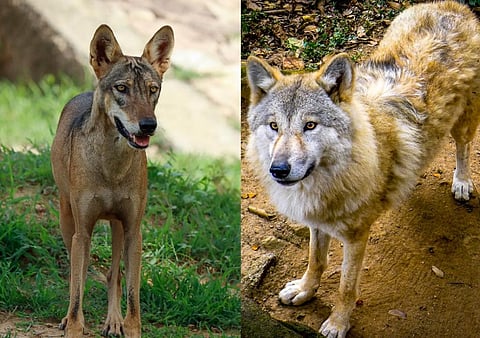

About half of the diet of both wolf subspecies found in India — the woolly or Himalayan wolf and the Indian wolf — is made up of domestic lifestock, a new study has stated.
The woolly wolf’s diet consisted of 20 different food items including small birds, reptiles to large mammals and domestic animals such as cattle and yak.
“Both the wolves of India depended on livestock for more than 50 per cent of their diet. Wolves across the world have been reported to feed on a wide variety of food items from animal matter to vegetative matter. Their main prey in most of the areas are large and medium-sized prey depending upon the availability,” the researchers concluded.
The woolly wolf is heavily dependent upon the domestic prey items in the Himalayan region. Livestock such as yak, Dzo cow, goat and sheep were the most consumed mammals in its diet, compared to sparsely distributed wild prey.
The researchers said the small population size and sparse distribution of the ungulate species in the region could be the reason behind the woolly wolf’s preference for domestic livestock.
“The Indian wolf primarily preyed upon medium-sized mammals relating to the availability of blackbuck, chinkara, and especially livestock such as sheep and goat. The Indian wolf-bearing states (Rajasthan, Andhra Pradesh, Maharashtra, Telangana) have the highest goat and sheep population,” the study said.
“The depletion of the natural prey base of these wolves is an important factor in their preferring livestock but not the only one. In both regions, the Himalayas and the Deccan Plateau, wolves have evolved with nomadic pastoralism by humans. Hence, they have always taken to depending on livestock for part of their nutritional needs,” Shivam Shrotriya, one of the authors, told Down To Earth.
Shrotriya and the other authors will be coming out soon with new research about human-wolf conflict over livestock in India. Other authors of the paper include Shaheer Khan (lead author), Sougata Sadhukhan, Salvador Lyngdoh, Surendra P Goyal and Bilal Habib.
Other findings
The study also found that the home range of the woolly wolf, found in the trans-Himalayas, is eight times larger than that of the Indian wolf, found in peninsular India.
The study found no differences in the howling parameters of these subspecies. It also found that the skull of the woolly wolf was significantly longer and broader than the Indian wolf.
The scientists made use of primary as well as secondary data to elucidate differences in movement, space use, habitat use, howling characteristics, cranial morphology and diet.
The researchers attached Global Positioning System collars on three woolly wolves in Himachal Pradesh’s Spiti and 11 Indian wolves in Maharashtra. These 14 animals were monitored from 2015 to 2021 to understand the movement, space use and habitat preferences of the two wolf lineages.
The researchers state that the large ranges of the woolly wolf could be due to sparsely distributed prey species and suitable habitat continuity.
The Indian wolf, on the other hand, survives in patchy, fragmented habitat within high human-dominated landscapes.
“In such landscapes where wild prey is almost absent, factors such as the type and distribution of food resources, human interference, and topography may have played a significant role in determining home-range size,” the study read.
The researchers found that the ‘mean displacement’ of Indian wolves was 35.2 per cent higher than the woolly wolves’ daily per hour movement.
The daytime and night time displacement of Indian wolves was 19.5 and 46.0 per cent higher than the displacement of the woolly wolf, respectively.
“Variation in the level of human disturbance could be the reason for Indian wolf being more nocturnal than woolly wolf,” the study stated.
The scientists compared the magnitude and pattern of howl acoustic structure to evaluate whether the long-range vocalisations showed acoustic differences between two wolf lineages in India.
“But we did not come across any specific differences,” Shrotriya told DTE.
However, the jury is still out on the taxonomic status of these two animals. Much confusion has existed among taxonomists and scientists about whether the woolly and Indian wolves are separate species from the gray wolf (Canis lupus) or are subspecies.
“This paper does not add any new data on genetics and morphology. It was not targeted at solving the taxonomic debate. Even the latest scientific papers on this issue published in 2019, 2020 and 2021 have not reached a final conclusion,” Shrotriya said.
“To add to the confusion, it has now been shown that the woolly wolf also ranges over the Tibetan Plateau, Central Asia and Mongolia,” he added.
“The wolves of Asia are paid less academic attention compared to their counterparts in Europe and America…We further suggest detailed morphological analysis and further studies should be conducted to understand the in-depth differences in ecological requirements of the subspecies,” the study noted.
Comparative Ecological Perspectives of Two Ancient Lineages of Gray Wolves: Woolly Wolf (Canis lupus chanco) and Indian Wolf (Canis lupus pallipes) was published March 15, 2022, in the journal Frontiers in Ecology and Evolution.